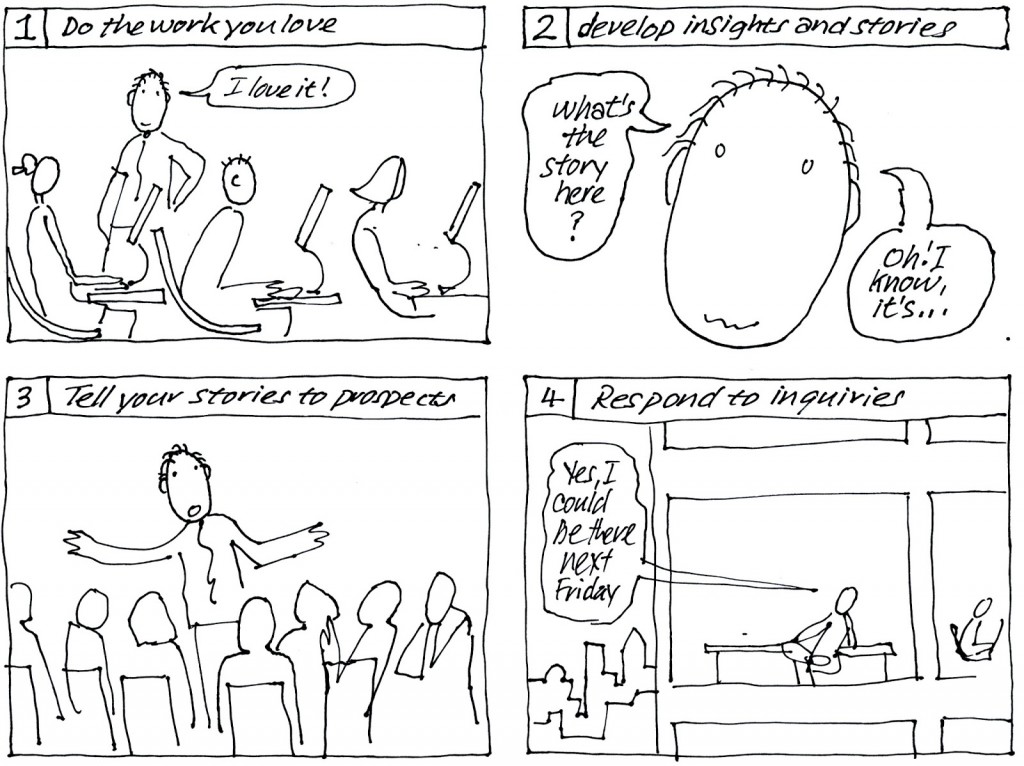Create a virtuous cycle that tells your story

How do you get work and, more importantly, gain a continuous supply of work with acceptable fees? Better yet, at greater than acceptable fees?
Suppose you’ve done a few similar projects, the work makes you happy, and you’re making decent money. With that, you have the beginnings of a niche and the possibility of a continuous stream of similar work.
You need to build an easily managed system to turn the possibility of continuing work into a reality. I like to call systems like this “virtuous cycles.” A term stolen from the economics world.
Step 1. Do the work
A virtuous cycle is a series of events that result in a favorable outcome time and again. For creative professionals, it means using your work and the insights gained from your experience doing the work to attract future clients.
The first step in the virtuous cycle is doing the work. Remember, your work and perspective differentiate you from your competitors. You are unique; therefore, your work is unique.
Think of it like this: No one does the work you do the way you do it and gets the outcome you get.
Step 2. Develop insights and stories
Each creative project you do adds to your knowledge base and allows you to form insights to help future clients succeed while furthering your differentiation from other creatives.
Those insights learned the hard way by doing the work are the source of stories that share your perspective with prospective clients.
To interest future clients, your stories must be about how your work helped existing clients succeed. They are about you only as reflected by your clients’ success.
Step 3. Get the stories in front of prospects
Email campaigns, public speaking, article placement, and new business pitches are all places to tell your stories. Post them on your site, blog, social media, and print and online publications. Find where your potential clients are online and post there.
Don’t think of your stories as case studies––case studies commodify and typically glorify the work in ways that don’t seem real.
Your stories must be personal, heartfelt narratives about helping others to succeed. Tell them with understanding and humility.
Step 4. Respond to inquiries
Inbound emails, texts, and calls prove your virtuous cycle works. These queries mean that they accept you as an expert, at least to the extent that they want to know if you can help them.
Given that they’ve responded to a story, seen you speak, or been referred, it reveals that in their mind, it’s a real possibility you can help them.
That inbound opportunity means you are accepted as an expert and qualified to ask for fees commensurate with your expertise.
Behave like the expert you are
Throughout this process, you must maintain and advance your expert status. Expert behavior is characterized by:
- Determining how to meet client needs.
- Asking questions and creating plans.
- Developing lists of deliverables required to achieve success.
- Developing budgets required to accomplish the scope of work.
- Writing contracts, not proposals.
Why the virtuous cycle is important
- Learning to think of your work as only the first step in gaining influence and opportunity is critical to achieving success.
- Whether you work for yourself or someone else, the four steps of the virtuous cycle will attract the opportunities that fit just you, furthering your unique expert status.
- Obviously, you’ll have a much more satisfying career if you are in demand.
- I’ve written this column to help you, but please note that it’s just a continuation of my virtuous cycle.
Based on real expertise, a well-managed Virtuous Cycle increases the possibility of getting more clients willing to pay higher fees.
I’ll repeat it for emphasis: remember, they can only get what you do, the way you do it, from you.

